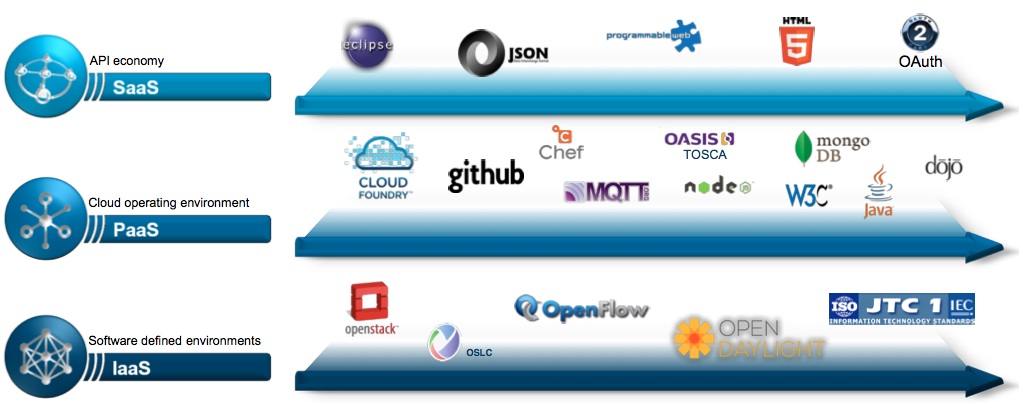Recently, I had the opportunity to attend the IBM Software Group’s Analyst Insights conference for the industry analyst community. IBM’s total revenue of about $100B comes from its combined hardware, software and services sales, but the software group contributes a large proportion of its profits. Cloud services require coordination from all IBM divisions, and it was no surprise that IBM focused an inordinate degree of attention at the event to non-software cloud products.
In this post, I will cover the challenges faced by legacy IT businesses by cloud computing trends, elements of IBM’s cloud strategy and a summary of my observations.
Challenges Facing Legacy IT Businesses:
- Hardware: Traditional enterprise hardware has been built with the CIO as a customer, and the vendor’s goal is to make the job of the data center operations manager easy. Hardware equipment must be easy to install and require minimal technical expertise to operate, while expensive contracts are designed to handle complex data center equipment maintenance services. In contrast, cloud service providers leverage commodity hardware for most or all their equipment. With the enormous capacity needed to deliver cloud services, contract manufacturers are recruited to build data center equipment to specifications written by the cloud provider.
- Software: Traditional software, a high margin product, is under attack from disruptive competitors. Software maintenance contracts consume a significant portion of the CIO’s budget. By leveraging open source software to build cloud services, cloud providers can build a volume business and disrupt the status quo of high margin software vendors.
- Services: Systems Integrators (SIs) have conventionally focused on custom software development and ERP implementations for driving revenue. Organizations that have modified software offerings, such as ERP packages, to suit their specific needs are now locked-in with a perpetual cycle of expensive upgrades. Comparable Software as a Service (SaaS) offerings are enticing customers with subscription billing without pricey upgrades. Adoption of SaaS-based Customer Relationship Management (CRM) and Human Capital Management (HCM) is growing in enterprises, reducing traditional systems integration service costs. While all systems integrators are challenged, those leveraging labor costs as a differentiator may find bigger barriers to overcome.

Some IBM Cloud Strategy Components:
- Ecosystem: Among technology companies, IBM has a large partner ecosystem supporting its current product portfolio. As the company continues to add new cloud capabilities to its arsenal, these partners must adapt to the new reality and modify their business strategies to provide managed services to customers. Increasing their attention to the needs of entrepreneurial partners could be a successful method of building new revenue streams, and IBM stated its plans and intentions to do just that. IBM is also working to attract the millennial developer audience to leverage its cloud services and platforms.
- Marketplace: Delivering cloud services through a marketplace has become a core competency of every cloud service provider. Progressive IT leaders will increasingly look for applications composed from multiple services purchased with a click of a button from a common platform. IBM understands the Application Programming Interface (API) economy in which developers can compose an application by mashing up multiple services glued together with API’s. With the breadth of their portfolio, IBM will need to deliver a simple, single and self-service marketplace to customers. IBM has unveiled plans to establish this marketplace with the expected launch of its codenamed BlueMix initiative, which will be formally launched in early 2014.
- Cloud Standards: IBM is focused on supporting and is heavily investing in helping develop open cloud architecture throughout their cloud portfolio and is committed to a number of standards including: OpenStack, Cloud Foundry, Topology and Orchestration Specification for Cloud Applications (TOSCA), and Open Services for Lifecycle Collaboration (OSLC). Some of these standards, like OpenStack and Cloud Foundry, are fairly new and will require more customer adoption before success can be guaranteed. IBM’s continued embrace of and investment in open standards help to give its own clients, as well as the industry at large, confidence in using open source technology.
Summary:
The Internet has enabled disruptors to challenge every legacy vendor product portfolio (especially those that command high profit margins) with new cloud delivered services. IBM has unique opportunities due to the depth and breadth of a portfolio that falls in the Infrastructure, Platform and Software as-a-Service (PaaS / SaaS) categories.
With a heritage of a huge services arm, IBM might have once advised customers they need additional skills to consume cloud services. But customers are now accustomed to purchasing services through a self-service model. IBM is transitioning to provide clients with the solutions and services they require in the ways in which they want to acquire them. The recent SoftLayer acquisition and an ever growing SaaS portfolio are proof of how the company is better positioned to capitalize on the cloud services market for clients, and for itself.
IBM “made an elephant dance” during the last big disruption of their business in the 1990s. IBM has successfully transformed itself a number of times before, and it will be interesting to watch this latest transformation unfold.

